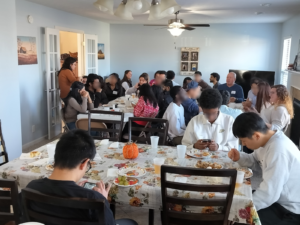The Huddles Groups Discipleship Model is utilized by our College Ministry at Morrison Heights Baptist Church. The approach was imagined by Mike Breen in his book Building a Discipling Culture. Matthew Young, Community Pastor at Resonate Church in Pullman, Washington, describes huddles in three ways:
• Vehicle for discipleship – Huddles are not discipleship; however, discipleship happens in Huddles. Your Huddle ought to be about hearing and obeying God’s voice. Meeting times, time spent together outside of Huddle; that is when discipleship is happening.
• Shared learning environment – When God teaches you something and you share that with your group, everyone learns. Huddles are not top-down; although there is a Huddle leader, he is not the only teacher. As God teaches you, teach other people.
• Obedience-based discipleship – The goal of Huddles is not to get you more information about God or the Bible (although that is a good thing!). The goal is to help you better obey God and the Bible. The only thing better than knowing more about God is obeying him more. To help you move towards obedience, Huddles focus on two things:
1) Spending time with the Lord in his Word
2) Learning shapes. The shapes are a way to understand and apply biblical truth. But the shapes aren’t lessons; instead, they’re Scriptural lenses you can use to view your life and respond in obedience.
BIBLICAL CONTEXT OF “KAIROS” IN HUDDLE GROUPS
In Mark 1:15, Jesus sums up his message by saying “The time is fulfilled, and the kingdom of God is at hand; repent and believe in the gospel.” When he uses this word time, he is using the Greek word “kairos.” Jesus is not referring to chronological time; instead, he is referring to a moment or event where one ought to respond
to God’s Word and change the trajectory of his or her life.
Huddles are designed to help disciples recognize these moments where God is speaking into their own lives and respond in obedience.
STARTING POINT-HOW TO BEGIN USING HUDDLE GROUPS
In order to utilize the Huddle Group Discipleship Model, leaders are encouraged to take the following steps:
• Have your staff or small group read through Building a Discipling Culture by Mike Breen. This will help you understand the approach and concepts used with the Huddle group approach.
• Once you understand the Kairos circle, begin using this method to disciple your core leaders.
• In the beginning, focus on inviting people who are committed to being disciples and desire to be disciple-makers.
• Find a person who is already leading a huddle in another church or ministry. Seek their help and ask them lots of questions. Ask them if they would be willing to coach you for a season.
MOVING FORWARD-HOW TO IMPLEMENT HUDDLE GROUPS
Once the concept of Huddle Groups is understood, a leader can move forward with developmental steps:
• In the weekly huddle times, disciples meet to do at least four things: pray for one another, share “Kairos” moments, share a plan of action, and then hold one another accountable to their “Kairos” moment from the previous weeks.
• Have disciples challenge one another to implement a regular time with the Lord in prayer and Bible study.
• Huddle leaders model discipleship and sanctification for their huddle by giving their huddle access to their life. Effective huddle leaders build their huddles on Christ-centered relationships.
• Huddles should meet together for a finite amount of time, typically around 9-12 months.
• Disciples should be told from the beginning that they will be asked at some point in the future to lead a huddle.
• Set a high bar with huddle participants. Tell them from the beginning that they are expected to participate every week and to have a regular daily time with the Lord.
ADVANTAGES AND CHALLENGES IN USING THE HUDDLE GROUP DISCIPLESHIP MODEL
Through the Huddle Group Discipleship Model, disciples can experience a variety of benefits:
1) Hearing God’s voice through his Word.
2) Articulating what God is calling them to do.
3) Forming a plan to obey.
4) Inviting others into a discipling and accountability relationship.
5) Encouraging brothers and sisters in Christ to pursue Christ-likeness.
However, some challenges must be overcome when using the Huddles Group approach. These challenges include:
1) Huddles are NOT meant to include non-believers. In fact, if a disciple isn’t committed to growing in his relationship with Jesus or isn’t even saved, that will have a negative impact on the huddle. However, huddles do propel disciples toward mission.
2) Huddles are high commitment for a long period of time.
3) Huddles are not top-down approaches to discipleship and require ministers to equip and then trust
disciple-makers.






